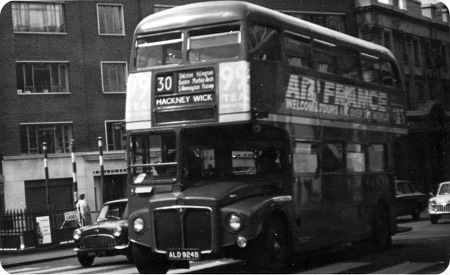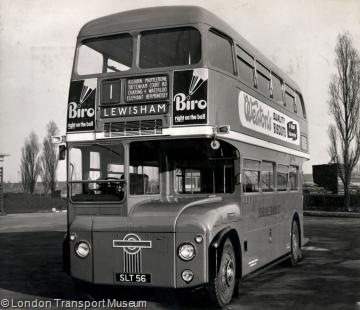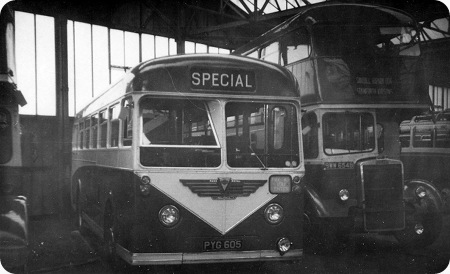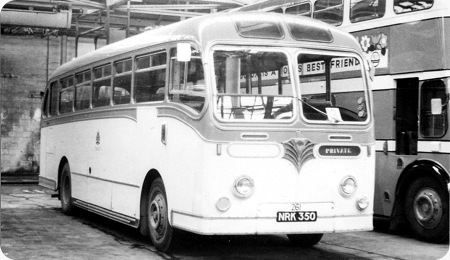London Transport – AEC Routemaster – ALD 924B – RM 1924

Photograph by ‘unknown’ if you took this photo please go to the copyright page.
London Transport
1964
AEC-Park Royal Routemaster
Park Royal H28/36R
Here is a nice action shot of a standard Routemaster, and it’s probable out accelerating the mini next to it. This particular vehicle had the Leyland O600 9.8 litre diesel engine and it would of had a throatier sound than the AEC engine. This was due to the fact that London Transport did not use air filters for some reason and it was the air entering the Leyland engine rather than the exhaust that produced the throaty sound. If memory serves me correct I think the London Transport practice of not fitting air filters meant that the RT had that lower bonnet line than the Provincial Regent.
The main reason for posting this shot is I visited Southport recently and found an excellent second hand bookshop that had a good selection of bus books and was lucky enough to get a copy of ‘Blue Triangle’ by Alan Townsin. One thing I noticed in the chapter for the Routemaster was that the prototypes had the radiator and fan positioned under the floor behind the engine bay. This explains how the first RM prototype achieved engine cooling when having no radiator just a solid panel with a London underground type logo on it, I have searched high and low for a shot on the internet to no avail I’m afraid. But fortunately by the time the first production model RM 8 appeared in 1958 the radiator and fan had been moved back to the normal position in front of the engine. This meant that the bonnet length had to be increased by 4 inch though to accommodate them and the good looking Routemaster that we all know came to be.
A full list of Routemaster codes can be seen here.
Bus tickets issued by this operator can be viewed here.
———

Photograph taken by Colin Tait in 1955
Here is a photo of RM1 SLT 56 with the solid front plate and bullseye motif, it’s worth observing that this prototype had no opening windows in the upstairs front.
Photograph courtesy of the London Transport Museum.
Chris Hebbron
———
The final design was far more balanced, and arguably more attractive, than the original.
There was an interim design of grille which had the LT bulls-eye on the round protuberance (just visible above the grille in the first photograph) and no "AEC" triangle at the top of the grille divider.
The final version (shown) had the LT bulls-eye but not the letters "AEC" on a triangle in the usual place.
There were, over a period of time, variations in the depth of the ventilation grille beneath the destination/route number indicators. (RM 1 is shown with standard route indicators – which it did not carry originally).
David Oldfield
———
Your comment about the throaty sound of the Leyland-engined RMs brought back fond memories of riding on one or two of them while I was on a week-long course at CAV in Acton in the early 80’s. The induction roar was absolutely gorgeous, and all the more audible as you say, due to the lack of an air filter. West Yorkshire Road Car had some Bristol RELH coaches (ECW and Plaxton bodies) fitted with 0.680 Leyland engines, which always sounded grand on the road. However, they had a similar induction roar when being tested on WY’s dynamometers at Central Works, as they were tested without air filters. I used to love running such engines in, and then fully bench-testing them on the dynamometers after overhaul. It was lovely (and quite addictive) to hear that roar – even with ear protectors on! The Routemasters had a lovely ‘song’ whether AEC or Leyland powered, as the accompanying melody from the transmission was so gentle and tuneful. Sadly, the tune went off somewhat when they were re-engined and re-gearboxed later in life, but at least it kept them running. P.S. Does anyone else think that someone has lost the plot somewhere with the ‘Borismaster’?
Brendan Smith
———
Simple answer – "Yes"
I drove for Reading Mainline on a casual basis.
Everyone knows I’m an A(mbassador) for E(xcellent) C(oaches) – and buses – but our two "Leyland" Routemasters were great fun and didn’t half shift (especially up – and down – Norcot Hill).
David Oldfield
———
22/04/12 – 07:34
Brendan, I’m so glad someone else is clearly so addicted to the Routemaster "melody". I fell in love with the Routemaster sound as a young lad and, some 40 years later, I am still totally absorbed by the unique harmonies of the engine (has to be AEC or Leyland) and the various parts of the transmission.
Mike Wakeford
———
22/04/12 – 16:10
What engines were used to re-engine the RM’s? I understood at one time that they were Italian, but would like to know if this was so.
Chris Hebbron
———
23/04/12 – 05:44
Chris, some of the power units used to re-engine the Routemasters were indeed Italian, these being of Iveco manufacture. Iveco is owned by FIAT, but I seem to recall it collaborated with Magirus and Ford to produce a range of commercial vehicles in the 1980s/90s. (The Ford/Iveco EuroCargo truck springs to mind). Other engines were also fitted to the Routemasters in later life, notably by Cummins and Scania. It was rumoured that Ken Livingston had planned to have the original Routemaster engines replaced with Gardner units at one point, as they had an excellent reliability record, were very economical, and were of British manufacture. The cost of the programme was said to have been too great however, given the perceived extended lifespan of the RMs/RMLs at the time, and so mass-produced engines were used instead. One also wonders if Gardner would have been able to fulfil an order for over 500 engines in time. Their engines were all hand-built from start to finish, and as well as building bespoke engines for the automotive industry, Gardner also built engines (plus gearboxes and pumps) for marine use. Therefore it would probably have been difficult to increase production simply by speeding up the various processes, or transferring production from marine to automotive. Such a shame though that we were cheated out of hearing the sounds of a ‘Gardner Routemaster’. I’m sure Mike and I would have found such a gentle beast just as delightful to the ear as the original AEC and Leyland-powered ones had been.
Brendan Smith
———
23/04/12 – 05:45
Chris. Three different engines were originally tried out and used to re-engine RMs. Cummins C (ie 8.3 Dennis Javelin), Scania DS 9 and IVECO 7.7. There was at least one DAF tried as well. The majority were Cummins, minority Scania, IVECO somewhere in the middle. IVECO is Italian (FIAT), but most of their PSV output is made in Spain. Later re-engines (like the "Heritage" RMs in Central London) have the Cummins B (5.9) as in the Dennis Dart and are know – less than affectionately – as Dartmasters.
The well preserved RML that I drive regularly has the IVECO engine – not a patch on the AEC or Leyland originals.
David Oldfield
———
23/04/12 – 05:46
I heard they (or some of them) were "Fix It Again Tomorrow’s."
Stephen Ford
Quick links to the - Comments Page - Contact Page - Home Page


